Intel's Pentium M Desktop Part II: ASUS' Pentium M to Pentium 4 Socket Adapter
by Anand Lal Shimpi on March 24, 2005 1:31 PM EST- Posted in
- CPUs
Workstation Applications
Visual Studio 6
Carried over from our previous CPU reviews, we continue to use Visual Studio 6 for a quick compile test. We are still using the Quake 3 source code as our test and measure compile time in seconds.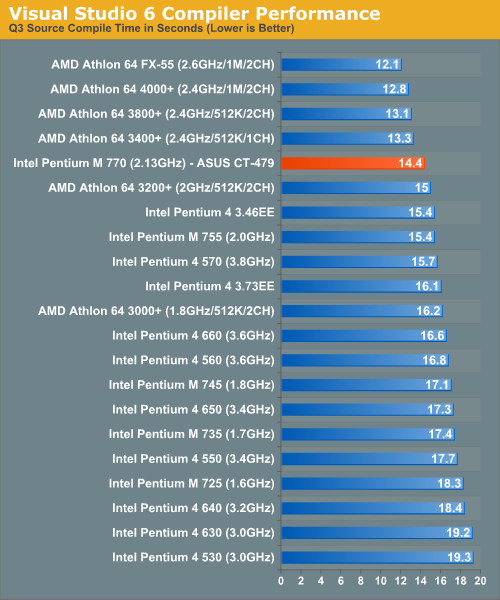
SPECviewperf 8
For our next set of professional application benchmarks, we turn to SPECviewperf 8. SPECviewperf is a collection of application traces taken from some of the most popular professional applications, and compiled together in a single set of benchmarks used to estimate performance in the various applications that the benchmark is used to model. With version 8, SPEC has significantly improved the quality of the benchmark, making it even more of a real world indicator of performance.We have included SPEC's official description of each one of the 8 tests in the suite.
The Pentium M doesn't excel in any of the SPECviewperf tests, but its performance is much more respectable with the ASUS solution, thanks to a more balanced memory bandwidth system.
3dsmax Viewset (3dsmax-03)
"The 3dsmax-03 viewset was created from traces of the graphics workload generated by 3ds max 3.1. To ensure a common comparison point, the OpenGL plug-in driver from Discreet was used during tracing.
The models for this viewset came from the SPECapc 3ds max 3.1 benchmark. Each model was measured with two different lighting models to reflect a range of potential 3ds max users. The high-complexity model uses five to seven positional lights as defined by the SPECapc benchmark and reflects how a high-end user would work with 3ds max. The medium-complexity lighting models use two positional lights, a more common lighting environment.
The viewset is based on a trace of the running application and includes all the state changes found during normal 3ds max operation. Immediate-mode OpenGL calls are used to transfer data to the graphics subsystem."
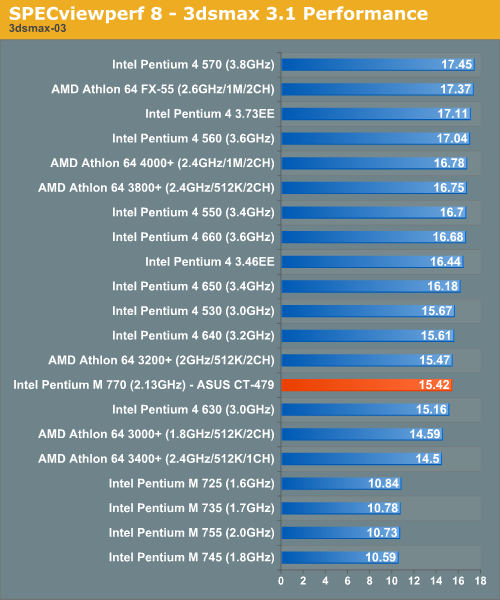
CATIA Viewset (catia-01)
"The catia-01 viewset was created from traces of the graphics workload generated by the CATIATM V5R12 application from Dassault Systems.
Three models are measured using various modes in CATIA. Phil Harris of LionHeart Solutions, developer of CATBench2003, supplied SPEC/GPC with the models used to measure the CATIA application. The models are courtesy of CATBench2003 and CATIA Community.
The car model contains more than two million points. SPECviewperf replicates the geometry represented by the smaller engine block and submarine models to increase complexity and decrease frame rates. After replication, these models contain 1.2 million vertices (engine block) and 1.8 million vertices (submarine).
State changes as made by the application are included throughout the rendering of the model, including matrix, material, light and line-stipple changes. All state changes are derived from a trace of the running application. The state changes put considerably more stress on graphics subsystems than the simple geometry dumps found in older SPECviewperf viewsets.
Mirroring the application, draw arrays are used for some tests and immediate mode used for others."
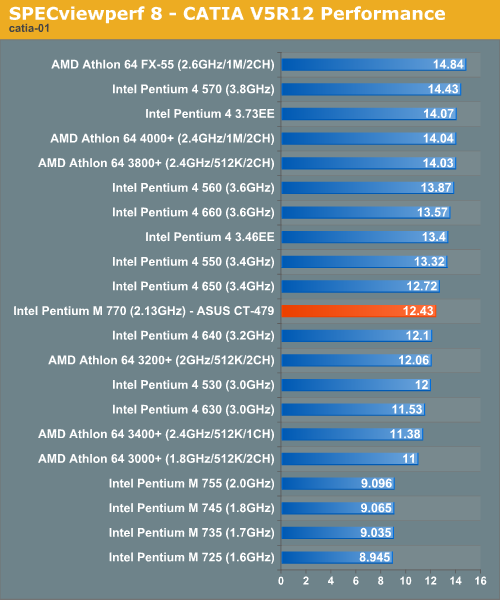
Lightscape Viewset (light-07)
"The light-07 viewset was created from traces of the graphics workload generated by the Lightscape Visualization System from Discreet Logic. Lightscape combines proprietary radiosity algorithms with a physically based lighting interface.
The most significant feature of Lightscape is its ability to simulate global illumination effects accurately by precalculating the diffuse energy distribution in an environment and storing the lighting distribution as part of the 3D model. The resulting lighting "mesh" can then be rapidly displayed."
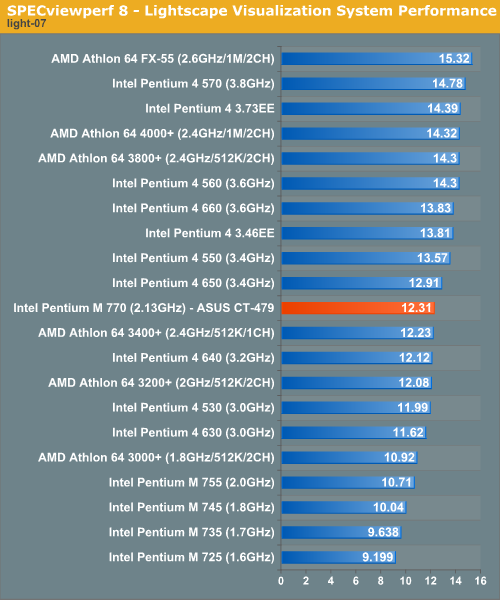
Maya Viewset (maya-01)
"The maya-01 viewset was created from traces of the graphics workload generated by the Maya V5 application from Alias.
The models used in the tests were contributed by artists at NVIDIA. Various modes in the Maya application are measured.
State changes as made by the application are included throughout the rendering of the model, including matrix, material, light and line-stipple changes. All state changes are derived from a trace of the running application. The state changes put considerably more stress on graphics subsystems than the simple geometry dumps found in older viewsets.
As in the Maya V5 application, array element is used to transfer data through the OpenGL API."
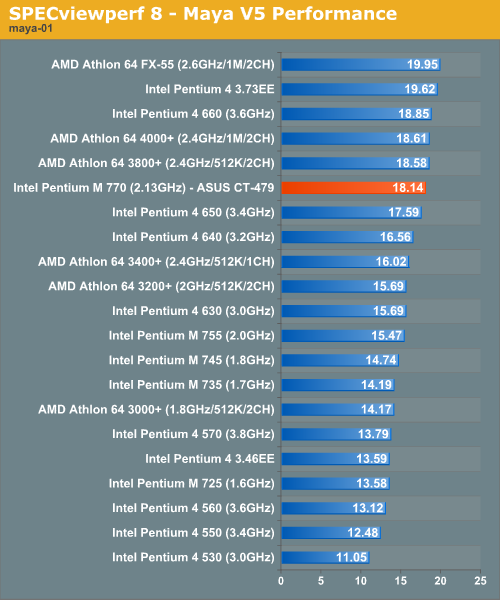
Pro/ENGINEER (proe-03)
"The proe-03 viewset was created from traces of the graphics workload generated by the Pro/ENGINEER 2001TM application from PTC.
Two models and three rendering modes are measured during the test. PTC contributed the models to SPEC for use in measurement of the Pro/ENGINEER application. The first of the models, the PTC World Car, represents a large-model workload composed of 3.9 to 5.9 million vertices. This model is measured in shaded, hidden-line removal, and wireframe modes. The wireframe workloads are measured both in normal and antialiased mode. The second model is a copier. It is a medium-sized model made up of 485,000 to 1.6 million vertices. Shaded and hidden-line-removal modes were measured for this model.
This viewset includes state changes as made by the application throughout the rendering of the model, including matrix, material, light and line-stipple changes. The PTC World Car shaded frames include more than 100MB of state and vertex information per frame. All state changes are derived from a trace of the running application. The state changes put considerably more stress on graphics subsystems than the simple geometry dumps found in older viewsets.
Mirroring the application, draw arrays are used for the shaded tests and immediate mode is used for the wireframe. The gradient background used by the Pro/E application is also included to better model the application workload."
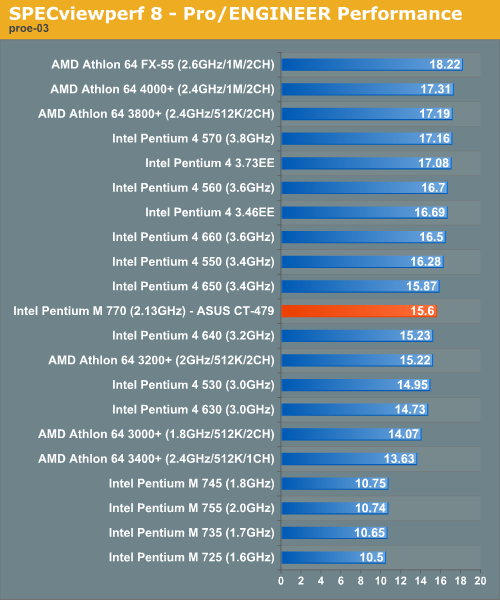
SolidWorks Viewset (sw-01)
"The sw-01 viewset was created from traces of the graphics workload generated by the Solidworks 2004 application from Dassault Systemes.
The model and workloads used were contributed by Solidworks as part of the SPECapc for SolidWorks 2004 benchmark.
State changes as made by the application are included throughout the rendering of the model, including matrix, material, light and line-stipple changes. All state changes are derived from a trace of the running application. The state changes put considerably more stress on graphics subsystems than the simple geometry dumps found in older viewsets.
Mirroring the application, draw arrays are used for some tests and immediate mode used for others."
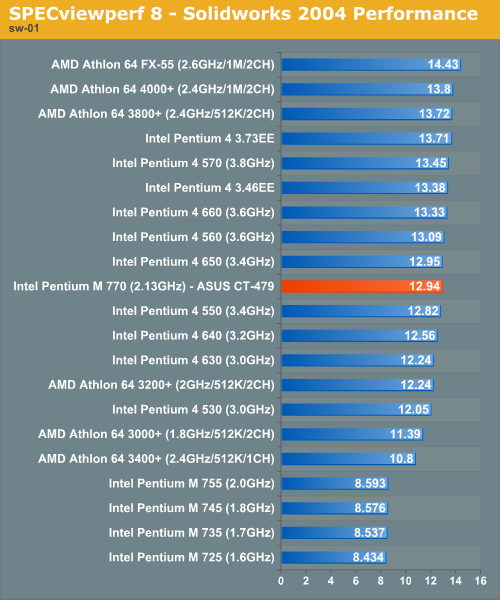
Unigraphics (ugs-04)
"The ugs-04 viewset was created from traces of the graphics workload generated by Unigraphics V17.
The engine model used was taken from the SPECapc for Unigraphics V17 application benchmark. Three rendering modes are measured: shaded, shaded with transparency, and wireframe. The wireframe workloads are measured both in normal and anti-alised mode. All tests are repeated twice, rotating once in the center of the screen, and then moving about the frame to measure clipping performance.
The viewset is based on a trace of the running application and includes all the state changes found during normal Unigraphics operation. As with the application, OpenGL display lists are used to transfer data to the graphics subsystem. Thousands of display lists of varying sizes go into generating each frame of the model.
To increase model size and complexity, SPECviewperf 8.0 replicates the model two times more than the previous ugs-03 test."
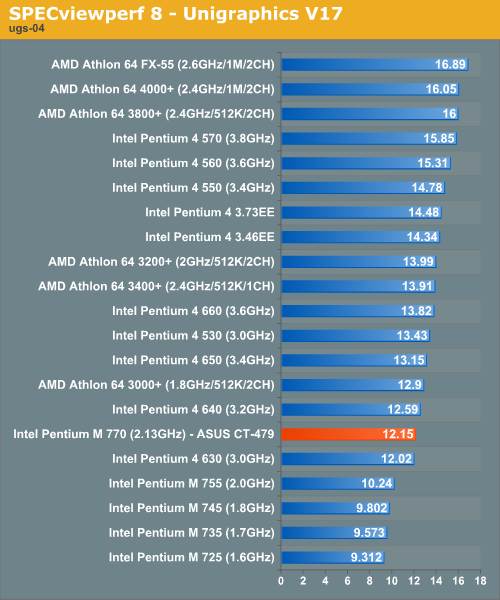










48 Comments
View All Comments
Houdani - Thursday, March 24, 2005 - link
With updates to floating point calculations and adding another core, Intel will need to think long and hard about putting their desktop chips into premature end-of-life in favor of going forward with the PM as their base product.Or, to summarize:
Blah blah blah nothing new that hasn't already been said before blah blah blather.
mlittl3 - Thursday, March 24, 2005 - link
Anand,You completely missed the point of the excellent data you obtained. Of course, this is just my point of view but here is my take on things.
The Pentium III stopped at 1.4 GHz. The Pentium picked up at 1.5 GHz (not including the low and ultra low voltage versions). We all know that the Pentium M is much more similar to the Pentium III than the Pentium IV. What if Intel never created the Pentium IV and continued improvements with the Pentium III? We would have had the Pentium M three to four years ago.
Intel screwed us all with its monopoly powers and sold high clock speeds to the masses with no thought about the performance of the Pentium IV. The last four years have shown us just that but no one complains or holds Intel accountable. As you have pointed out numerous times, the capital processor of the Pentium IV series, the Pentium IV EE is a complete waste of money.
In almost all of your benchmarks, the Pentium M shows almost the EXACT same performance as an Athlon 64 clock for clock. I say again, what if the Pentium M was developed at the time the Pentium III was discontinued? Intel and AMD would have matched clock speeds and we would have a Pentium M around 2.6 GHz right now with the similar performance of the Athlon 64 FX-55. The improvements you mentioned in the conclusion for Yonah (SSE and floating point) would probably already be implemented.
The Pentium M is THE processor from Intel. We had to wait four years for Intel's monopoly to be weakened but now we have a processor worth something. With multiple cores (each running at the speed of single cores since the Pentium M runs so cool) and all the other improvements from Yonah, that processor is going to be awesome.
Thank god for AMD challenging Intel with their terrific Athlon 64 architecture. Without them, computer processing would be in the dark ages. Guys, we need to stop supporting companies when they get to a certain size. The market needs to shift or we are going to get software like Windows and processors like the Pentium IV. With an even market share split between at least two companies, technology will excel past our wildest imaginations.
Okay, I will shut up now. I do want to add one thing. The ASUS adapter does nothing over the Aopen motherboard. If I am not mistaken, you compared a 533 MHz FSB, 133 MHz faster Dothan Pentium M to 400 MHz FSB, slower Dothans (I hope the other processors were Dothans and not Banias). The performance delta between the 770 and the 750 is exactly what you would expect from a faster clocked processor and a faster FSB. The 865 vs. the 855GME had nothing to do with the performance difference. The only advantage of the ASUS adapter is a cheaper overall cost of ownership.
bob661 - Thursday, March 24, 2005 - link
Oh yeah, if you're going Intel, this is the only CPU to own.bob661 - Thursday, March 24, 2005 - link
Intel really needs to lower the price of this CPU. A 765 is $645 on newegg. I can only imagine what the 770 would cost. If it was more price competitve, the P-M would be an excellent processor choice.rqle - Thursday, March 24, 2005 - link
i thought it did pretty well clock for clock on majority of the benchmark against the amd64 and did on par or so on gaming against the amd FX chips. Where it exceeds the PM it deal extremely well, and falls really shorts on things it didnt fair to well.Price wise for a "Desktop", i still believe AMD64 chip is the way to go. Great notebook chip that is not quite ready for the desktop area yet, need to improve its floating point performance and some desktop area. Did pretty well as gaming chip.
clarkey01 - Thursday, March 24, 2005 - link
Multitasking..lol...I mean, your going to get Intel fanboys saying " Its only has a 400 MHZ FSB" and what not. Well, why has it > ? its like saying the FX only has one meg cache, why doesnt it have two ?
clarkey01 - Thursday, March 24, 2005 - link
Mixed bag or what.Aileur - Thursday, March 24, 2005 - link
All in all seems like a middle of the pack solution. I thought the dual channel would give it a more significant boost but the pentium m seems to stay in the middle of the pack most of the time.I would still get it before i ever touched a prescott with a ten foot pole (and im an ex northwood user) but for the price theyre asking for dothans I dont see it being the desktop chip killer i was expecting.
I wonder though how Intel could clock this thing if it didnt have low power/heat in mind.